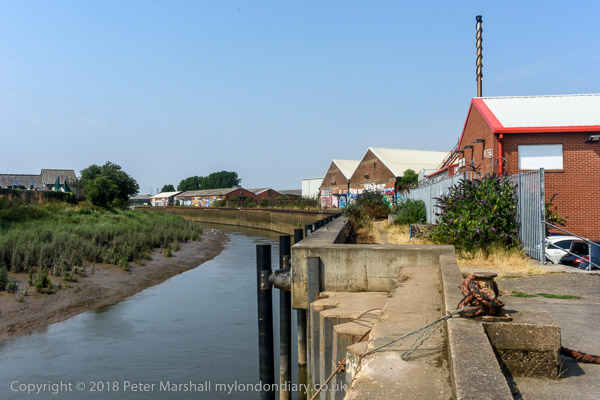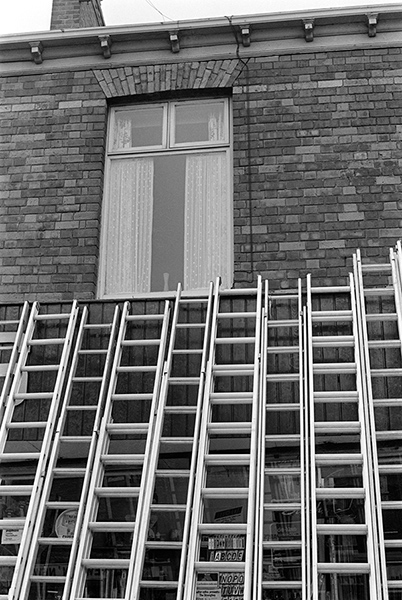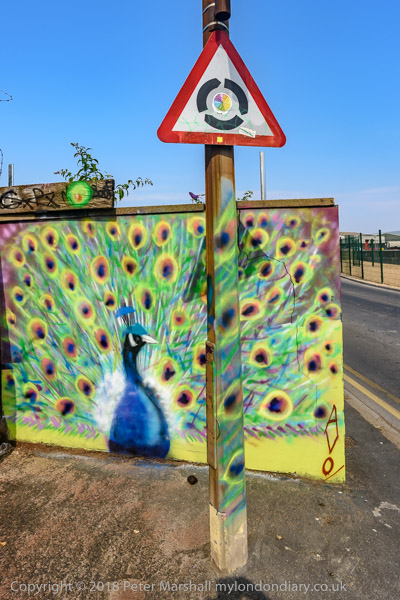Kings Cross and Pentonville: Although I took a few pictures in the next few weeks, mainly on my way to or from meetings, it was well into February before I was able to go on another long photographic walk. Of course the weather at that time of year often isn’t too kind and days are short, but winter is the best season for photographing much of London’s buildings, as so much is hidden once trees come into leaf.
I can’t now recall why I decided to return to the Kings Cross area on Sunday February 11th 1990, though I liked to revisit areas periodically, and the journey to the Victoria line station was an easy one, suitable for short days to give me more hours of usable light.
I left the station by the Pentonville Road entrance and walked back towards the main station, taking a couple of pictures on my way before heading down Grays Inn Road. This picture looking back towards Kings Cross Station includes both the station clock tower – I seem to have arrived shortly before 10am – and the well-known “lighthouse” built simply as advertising for Netten’s Oyster Bar. What seems an incredibly long horizontal pole holds one of the many traffic lights in the area .
In the centre of these fly-posted posters is an advert for ‘THE BEST SHOP IN TOWN’, SHE-AN-ME at 123 Hammersmith Road, West Kensington, London W14. It offers ‘UNUSUAL – BONED DRESSES – 6″ HEEL BOOTS – LATEX RUBBER …’ and much more, a fetish shop specialising in PVC, rubberwear and bondage equipment. Although Yelp still has a listing for the business it is long gone; after some years as ‘Simply Pleasure’ it is now ‘Quick Local Store’ selling snacks, cold drinks, tobacco, souvenirs, toiletries and household items.
One of London’s more photographed signs, though now a little faded and above a Nail Bar and Computer Centre on this nicely curved building. The Greek Restuarant at 325 is now a fast-food place – and is flanked by two others.
I walked back onto Pentonville Road, here the boundary between the London boroughs of Camden and Islington. Modern Jock’s Tattoo Studio on the south side was on the ground floor and Chestnuts Hair Studio for Men and Women through the same door on the first floor, illustrated by arrows for the non-literate. Born around 1920 British tattooing legend Jock Liddel started as a tattoo artist at the age of 16 in Scotland and his famous shop was at 287 Pentonville Road for many years. He died in 1995 but had moved down to Kent a few years earlier. His shop and several adjoining are now an American multinational fast food burger and fries chain.
‘Kings X People Say NO’ to the Chunnel Terminal for Kings X – Chaos for London’ read the array of posters on the back of a road sign, one of four signs in this picture, along with those for the Autodrome, Peacemeal Whole Foods and Loseley Dairy Ice Cream.
I was briefly and peripherally involved with the Kings Cross Railway Lands Group and their ‘Planning for Real’ exercise with local residents which formed a basis for the comprehensive alternative plan published in their Kings Cross Railwaylands Towards a People’s Plan Full Report published in October 1991.
Of course their plans were not adopted but the opposition certainly played a part in the decision to drop the plans for a new Kings Cross and instead to develop St Pancras as the international terminal. As an article on Londonist points out, “The plans would have seen 83 homes and 58 shops demolished. The scale of destruction would have witnessed landmark listed buildings like the Scala pulled down … The entire block between Caledonian Road, York Way and Caledonia Street would have also been lost.”
The Kings X Sauna on the corner of Northdown Street and more useful shops and offices on Caldedonian Road. The sauna at No.70 later became an estate agents.
Further north on Caledonian Road I turned west into All Saints St where I photographed Mercantile House which appropriately later became home to global brand consultancy agency Wolff Olins – who have now moved to Southwark.
Work began in 2022 to transform this and other buildings on the site into Regent’s Wharf, “a ground-breaking new campus … created with the next generation of innovators in mind.”
Mercantile House was built in 1891 as the Head Office for Thorley’s Food for Cattle with their mill behind it on the bank of the Regent’s Canal. They had moved onto the site in 1857.
“A family owned business for over 100 years, Joseph Thorley’s Ltd was an iconic player of the industrial age, inventing and distributing ‘spicy aromatic condiments’ that would beef up your cattle, pep up your pigs and ensure your chicken laid the best clutch in the roost.
This MiracleGro for animals was made to a secret recipe and sold around the world even in far flung outposts such as the Falkland Islands, all from the headquarters at Regent’s Wharf in King’s Cross.”
“Thorley’s progressive ideas extended to their charming and playful marketing, with eye-catching advertising and branding that has become collectable today. Animal feeds went by many wonderful names such as Grula for Horses, the famous Thorley’s Cake that reared ‘Champions’, Ovum for chickens and Rabbitum.”
More from this walk later.
Flickr – Facebook – My London Diary – Hull Photos – Lea Valley – Paris
London’s Industrial Heritage – London Photos
All photographs on this page are copyright © Peter Marshall.
Contact me to buy prints or licence to reproduce.





























